Faster and more accurate: a hybrid system of heterogeneous qubits
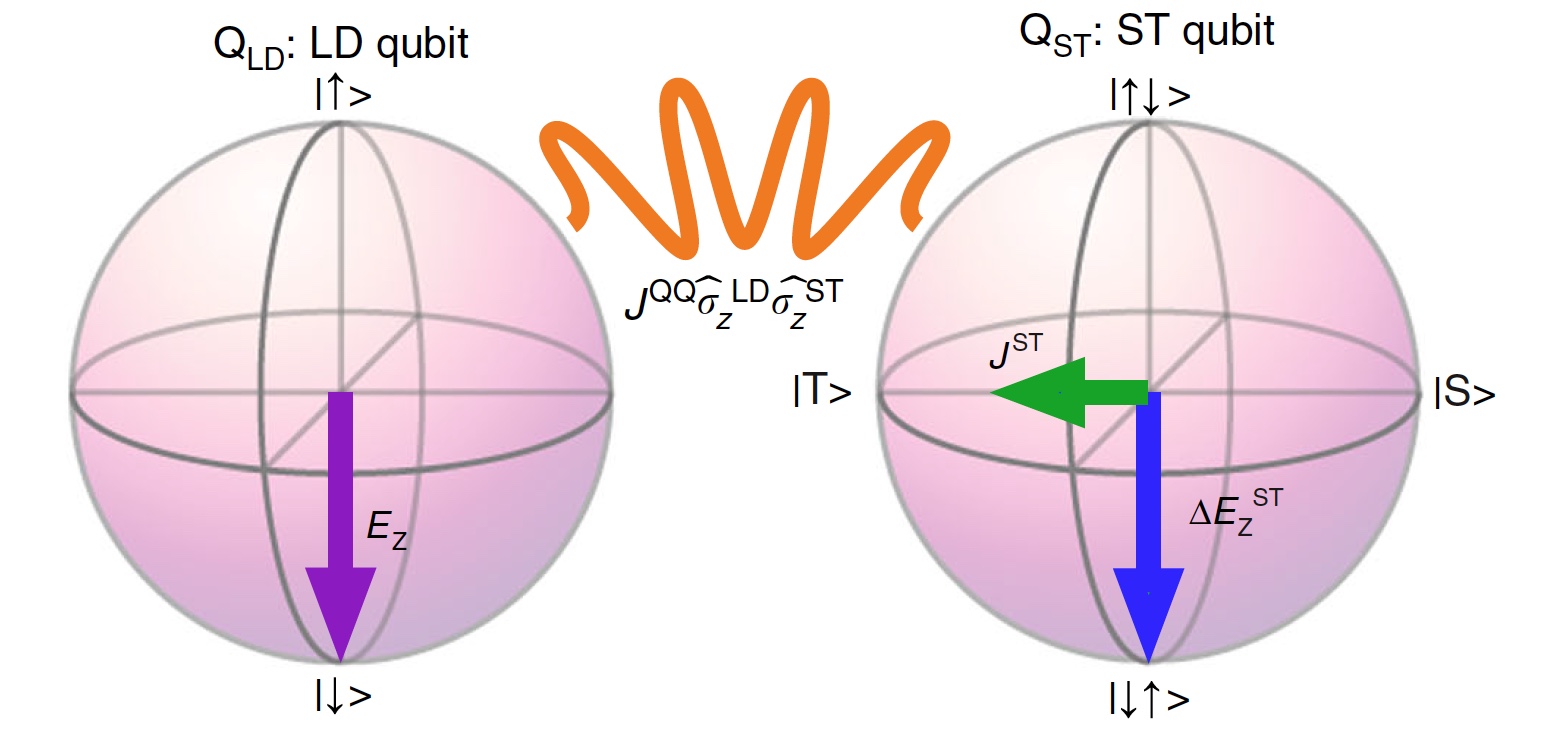
Some ideas are brightly born and die quickly due to the complexity, high cost or even the uselessness of implementation. Killer shark with laser settings on his head - it sounds very cool, very difficult and incredibly ridiculous. However, some ideas in their implementation promise, if not the "golden mountains", then at least a pot of gold. This also applies to quantum computers, which promise to be super powerful, super fast and very energy efficient. Sounds good, isn't it? So many scientists think the same way. The implementation of quantum computing requires solving many problems. And today we are going to get acquainted with the study, in which scientists decided to improve the rates of speed through the creation of the so-called qubit hybrid. What it is, what it consists of and how it works, we learn from the report of the research group. Go.
The basis of the study
In order for everyone to be clearer, scientists first of all emphasize several aspects that precede their study. Firstly, these are single-spin qubits in semiconductor quantum dots, which can provide an incredible level of accuracy of quantum single-qubit gates up to 99.99%. Secondly, these are two-qubit gates with a long coherence time.
A quantum gate * is a logical element that converts the input state of a qubit to an output state according to a certain law.The problem is that the initialization process and the actual reading of qubits are an order of magnitude slower than the control process. And this is an extremely negative impact on the implementation of protocols based on measurements. These include error correction.
But this already sounds depressing, but not for our researchers. They note that a singlet-triplet qubit embedded in a two-spin subspace can have both high accuracy and high speed. It is these elements that are the basis of the hybrid system, through which scientists were able to realize a quantum valve of the controlled phase at a speed of 5.5 nanoseconds, which is several times faster than the dephasing time.
Dephasing * is a mechanism for extracting classical features from quantum systems. Refers to the decay process of the coherence of a quantum system.The main, so to speak, details of the hybrid system (CPHASE) are two types of qubits, each of which has its own advantages and disadvantages: Lossa-DiVinsenzo qubit (hereinafter LD) and singlet-triplet qubit (hereafter ST).
In LD qubits, the two-qubit quantum gate is fairly fast, since it concentrates on the exchange processes between adjacent spins. But ST qubits are much slower because they are limited by a weak dipole coupling.
In the processes of initialization and reading the situation changes dramatically. LD qubits become slower due to spin-selective tunneling. And ST are many times faster because of the Pauli principle.
Thus, we have two types of qubits that show themselves well in certain processes. If you combine their advantage in one hybrid system, then you can get faster and more accurate quantum calculations. And for this it is necessary to create a connecting interface between them, which scientists did in their research. Let's find out how successful their work was.
Results of the study
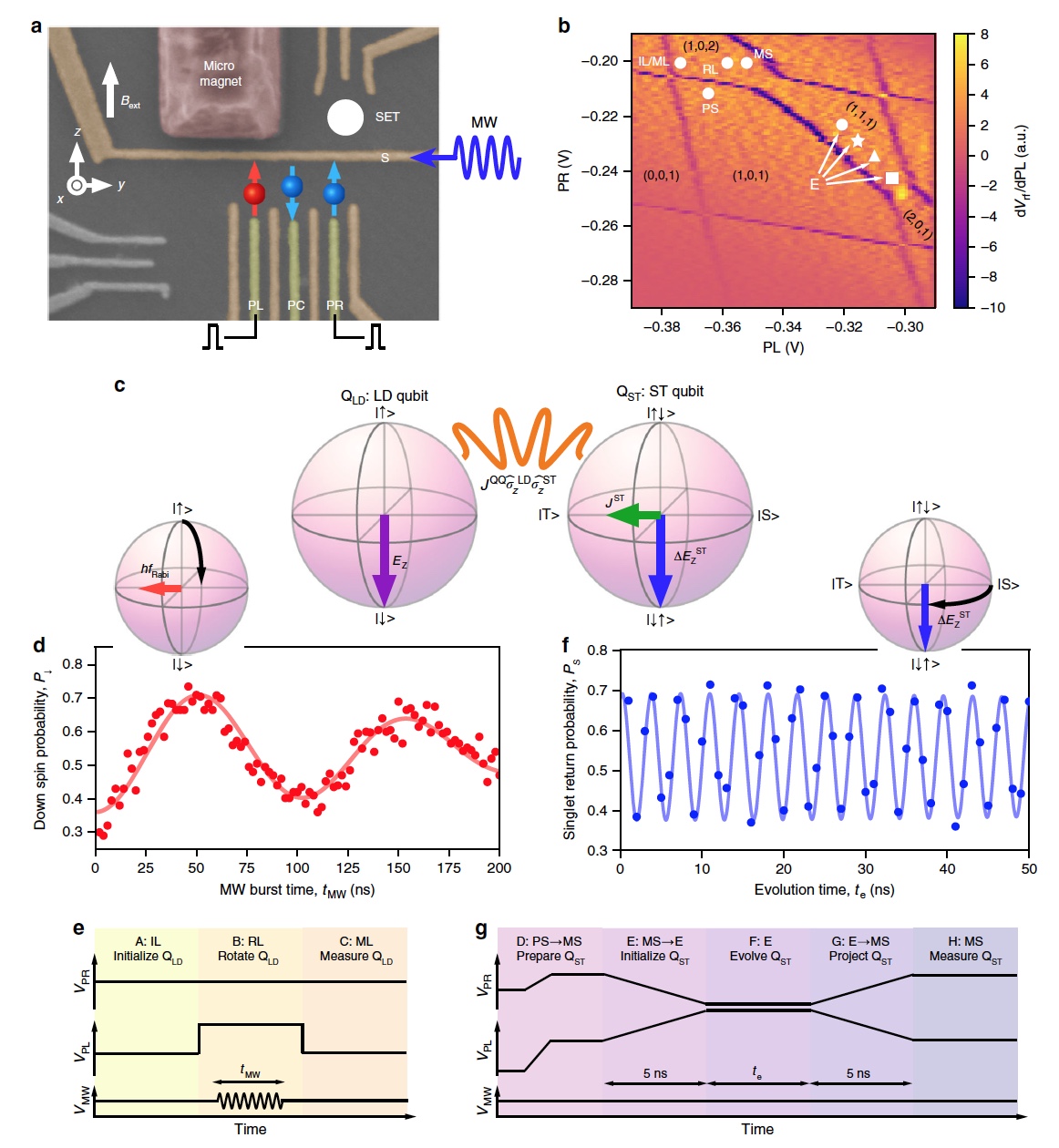
Image No. 1
In image 1a, we see how the LD and ST qubits were implemented in a triple quantum dot (TQD). The LD qubit is formed at the left point, and the ST is located at the other two.
To achieve coherent and resonant control over the LD qubit, scientists have added a micromagnet alongside TQD. This was accomplished by means of an electric dipole spin resonance (EDSR) —a method of controlling the magnetic moments in the system through quantum mechanical effects, such as spin-orbit coupling.
This also made it possible to increase the difference in Zeeman energy between the central and right points in comparison with their exchange interaction.
Zeeman energy * is the external potential energy of spins in a magnetic field.Thus, the intrinsic ST state of the qubit at these points becomes | ↓⟩ and | ↓ ↑⟩, instead of the singlet | S⟩ and triplet | T⟩. Further, an external magnetic field of 3.166 T (Tesla) was applied, which made it possible to separate the LD qubit states according to Zeeman energy and separate the polarized triplet states | ↑ ↓⟩ and | ↓ ↑⟩ ST qubit from the computational states.
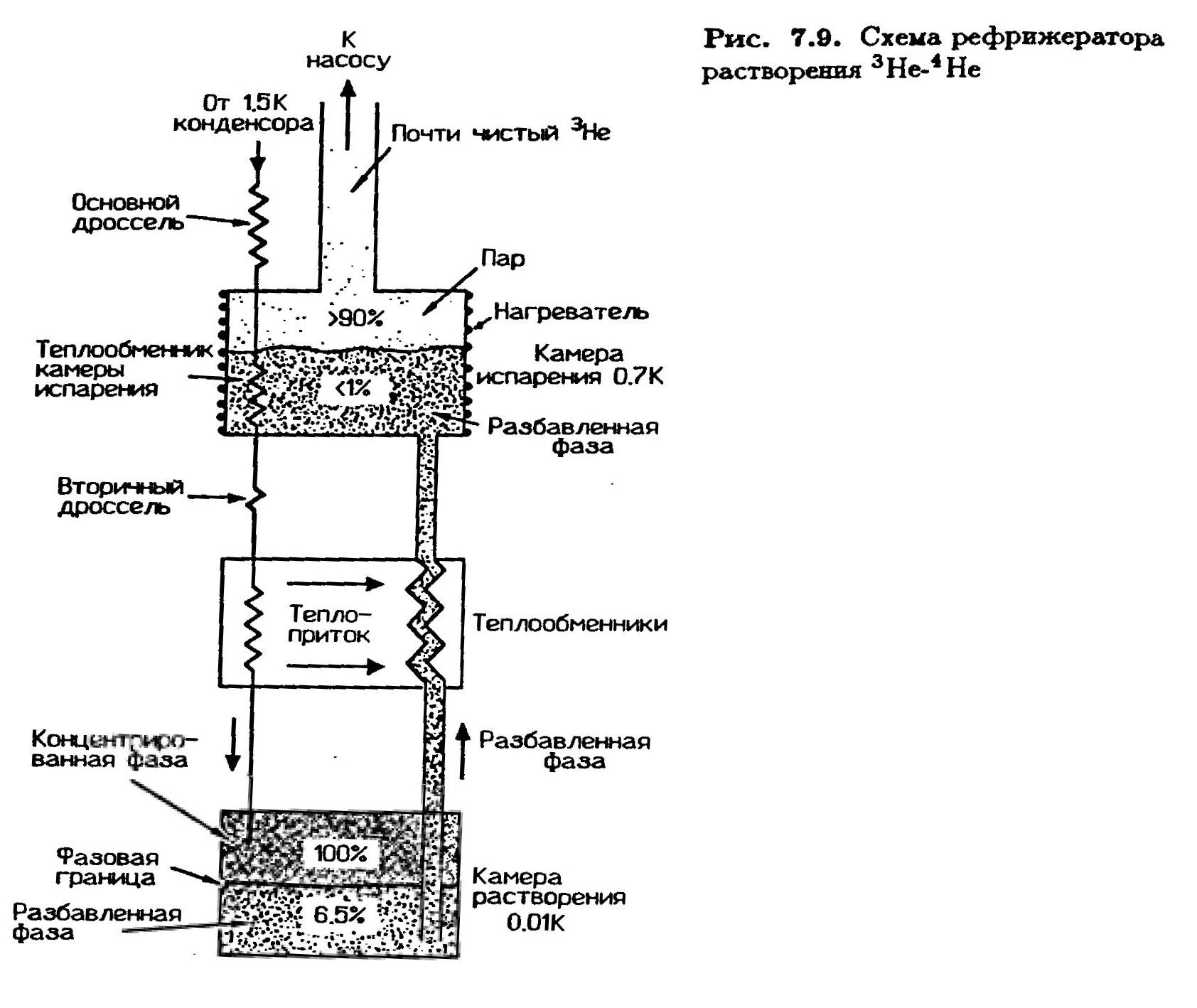
Scheme of the dissolution refrigerator ( Source for those who want to learn more about the principles of operation of this device).
The experiment itself was conducted in a special dissolution refrigerator at a temperature of 120 mK (millikelvin). Qubit manipulations were carried out at the charge state (1,1,1), initialization at (1,0,1), and reading at (1,0,2).
(N, N, N) * is the number of electrons inside each of the points (left, central and right).To calibrate the processes of initialization, control, and reading, measurements of changes in the coherence time for each qubit were carried out. In order to reduce the intercubit exchange interaction, scientists dramatically changed the energy level of the charge states (1,1,1) and (2,0,1).
When observing the LD qubit, a Rabi oscillation with a frequency of 10 MHz ( 1d ) was detected as a function of the microwave pulse time ( 1e ). At ST qubit, precession was observed between | ↑ ↓⟩ and | ↓ ↑⟩ ( 1f ).
The image 1c illustrates the process of linking two qubits to each other through the exchange interaction between the left and central quantum dots.
The two-bit system was operated in accordance with the following condition:
E Z ≫ ∆E ST Z , ∆E QQ Z J QQ ≫ J ST , where:
E Z is Zeeman energy;
∆E ST Z is the difference between the Zeeman energy between the right and central points;
∆E QQ Z is the difference between the Zeeman energy between the left and center points;
J QQ - exchange interaction between the left and central points;
J ST is the exchange interaction between the right and center points.
In this case, the Hamiltonian of the system will be as follows:

where ^ σ LD zand ^ σ ST z are the Pauli z-operators for LD and ST qubits, respectively.
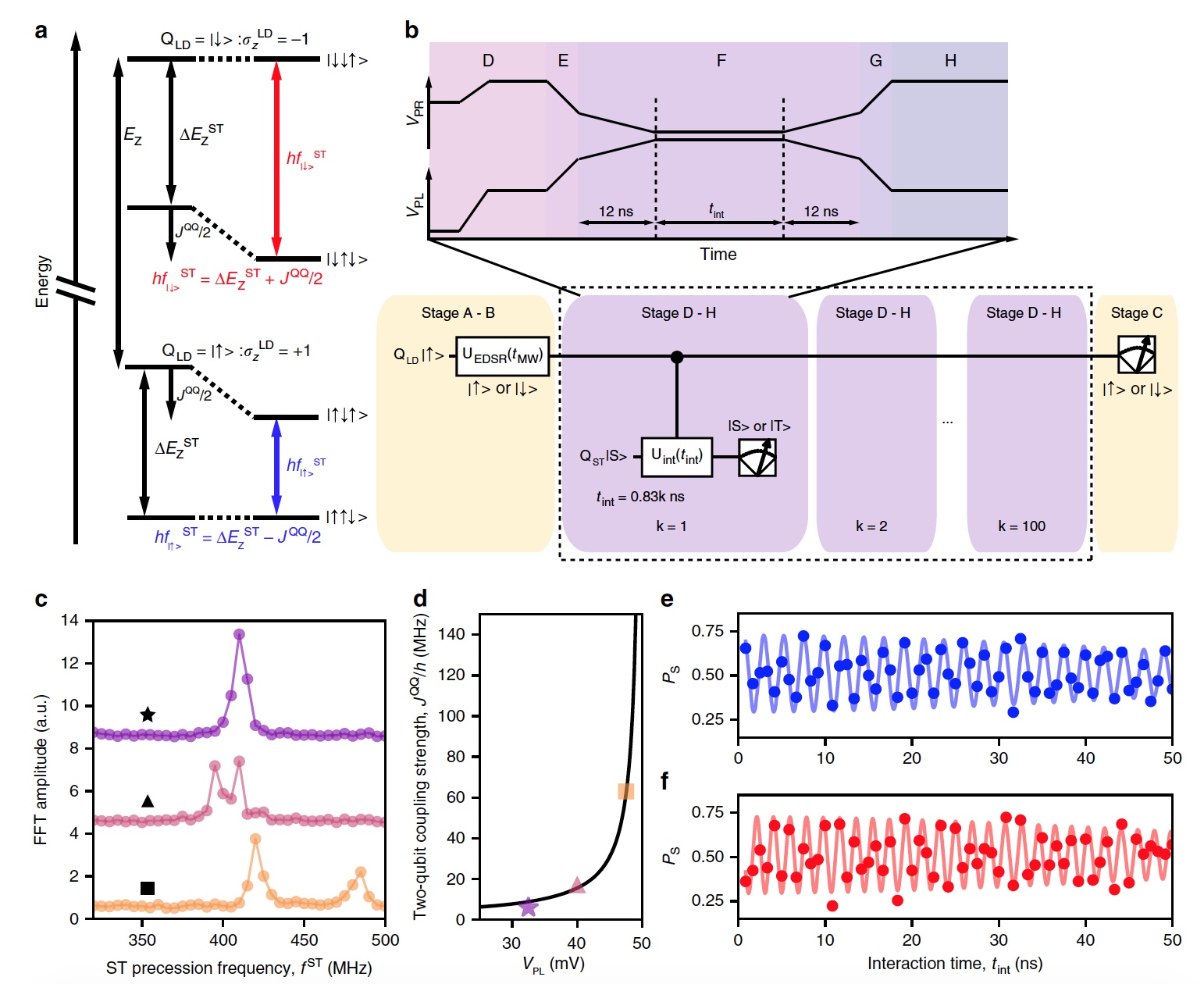
Image No. 2
Before testing the two-qubit valve as an actual example of the operation of the hybrid system, the scientists calibrated the inter-qubit interaction force and its variability by manipulating power levels.
The man-to-bit interaction in a pulsed state was controlled by changing the energy between (2.0.1) and (1.1.1) charge states ( 2b ). And to prevent losses in the computational state of the ST qubit, the inter-qubit exchange interaction was switched on and off adiabatically by introducing linear voltage changes (maximum 24 nanoseconds).
The coherent precession of the ST qubit was measured by repeating the pulse states from D to H (image No. 2) without initializing, controlling and measuring the LD qubit, which made the latter a mixture of | ↓ ↑ and | ↓ ↑⟩ in a random order.
Figure 2b shows in detail the quantum circuit used in the experiment to demonstrate the possibilities of controlling the precession frequency ST of a qubit by means of an introductory state of the LD qubit. Using either | ↑ ↓⟩ or | ↓ ↑⟩ as the initial state, the ST precession was obtained ( 2e , 2f ).
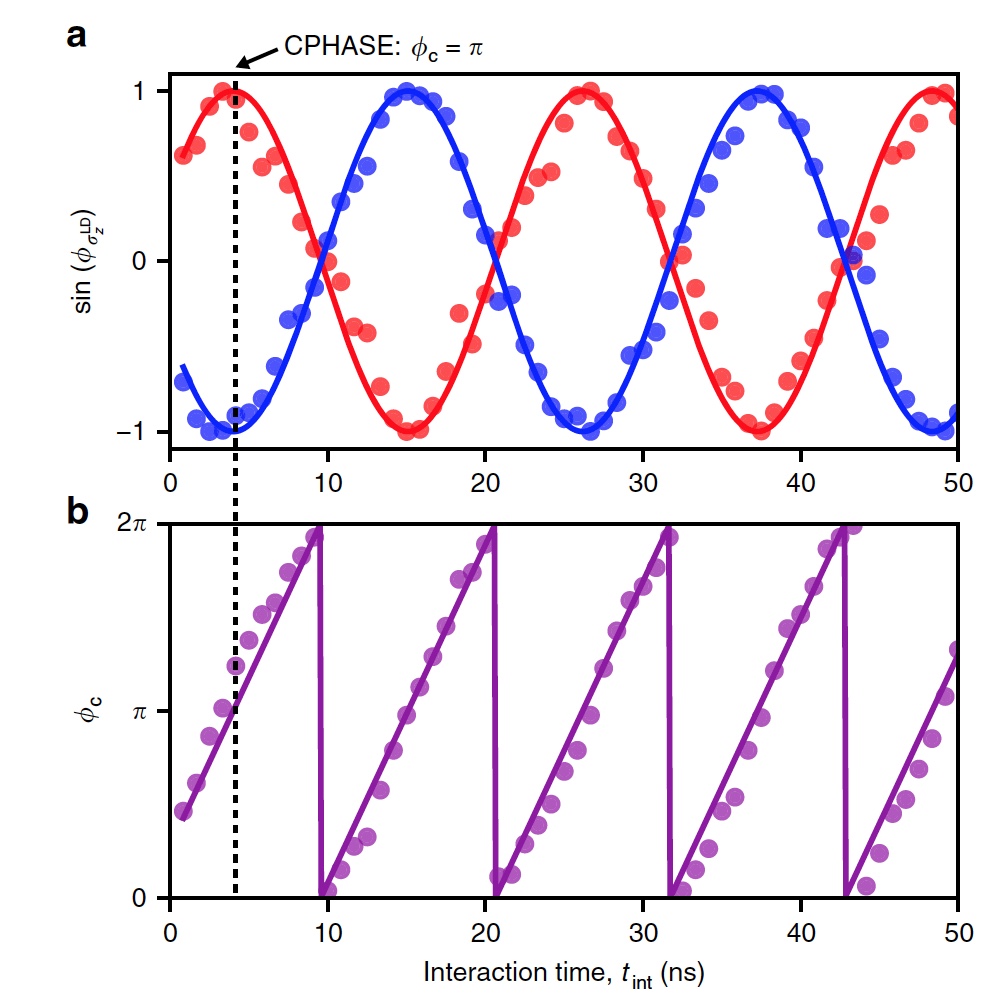
Image No. 3
Image 3a shows the dependence of the initialization time on the phase ϕσLD, graph 3b already shows the controlled phase ϕC = ϕ | ↓〉 - ϕ | ↑〉 .
Observations have shown that the time required for the valve tested by CPHASE can be 5.5 ns. However, at the same time, the maximum likelihood time was 211 ns. Scientists attribute this to the fact that the shorter data collection time obtained here “cuts off” the low-frequency component of the noise spectrum.
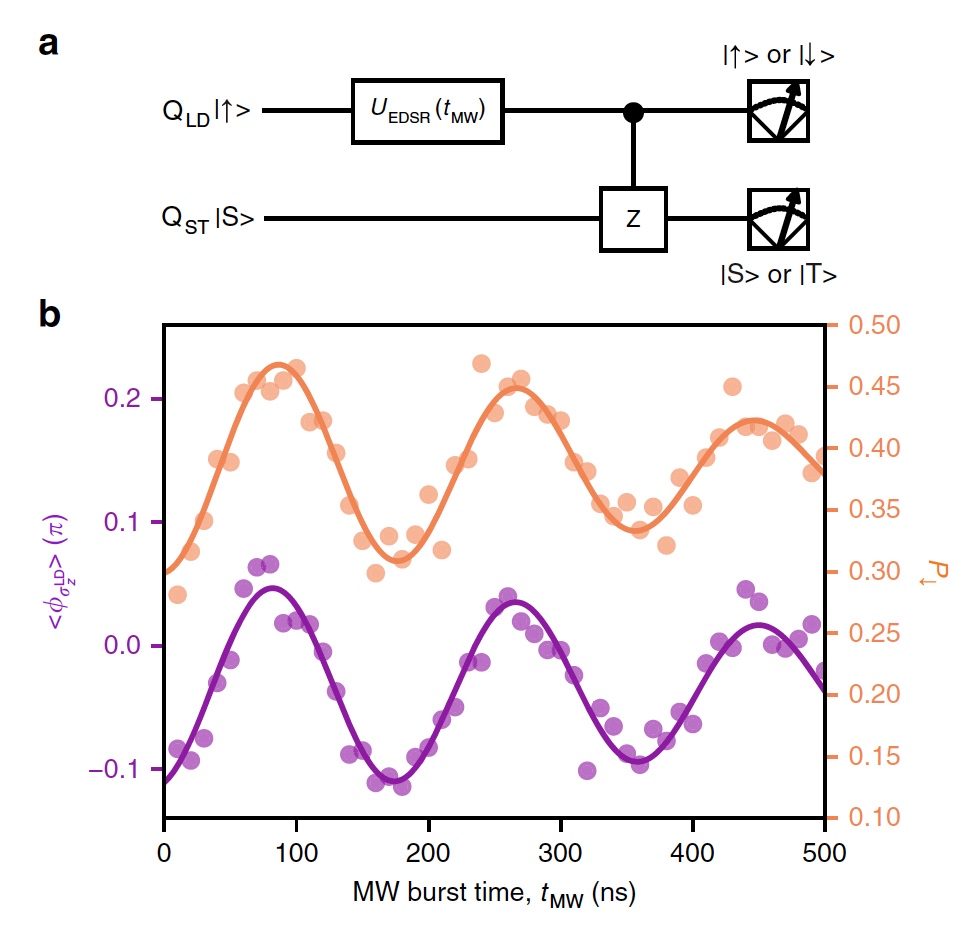
Image No. 4
Next, the scientists demonstrated that the CPHASE valve is able to work absolutely perfectly even with the introduction of arbitrary input states of the LD qubit. Figure 4a shows the quantum circuit used for this, in which the implementation time is fixed to satisfy the condition ϕ C= π. In this case, a coherent initial state of the LD qubit with an arbitrary σLD z is prepared by means of an electric dipole spin resonance.
For a more detailed acquaintance with the nuances of the study (methods, calculations, formulas and observations) I strongly recommend to look into the report of scientists and additional materials to it.
Epilogue
No chapel perfection. This statement, as a bearded anecdote, it has already been heard a hundred times, but it continues to be relevant. Quantum computation, although they promise us a bright new world, but to realize them, it still takes a lot of effort to apply, research and issues to be solved.
However, this study brings the implementation of quantum computing at a practical level a step closer to reality. Using the advantages of different types of qubits in one hybrid system allows us to achieve not only high accuracy of quantum processes, but also a fairly high speed of their execution. And such a combination has always had and will matter, whatever the calculations themselves.
Thank you for staying with us. Do you like our articles? Want to see more interesting materials? Support us by placing an order or recommending to friends, 30% discount for Habr's users on a unique analogue of the entry-level servers that we invented for you: The whole truth about VPS (KVM) E5-2650 v4 (6 Cores) 10GB DDR4 240GB SSD 1Gbps from $ 20 or how to share the server?(Options are available with RAID1 and RAID10, up to 24 cores and up to 40GB DDR4).
VPS (KVM) E5-2650 v4 (6 Cores) 10GB DDR4 240GB SSD 1Gbps until spring for free if you pay for a period of six months, you can order here .
Dell R730xd 2 times cheaper? Only we have 2 x Intel Dodeca-Core Xeon E5-2650v4 128GB DDR4 6x480GB SSD 1Gbps 100 TV from $ 249 in the Netherlands and the USA! Read about How to build an infrastructure building. class c using servers Dell R730xd E5-2650 v4 worth 9000 euros for a penny?
